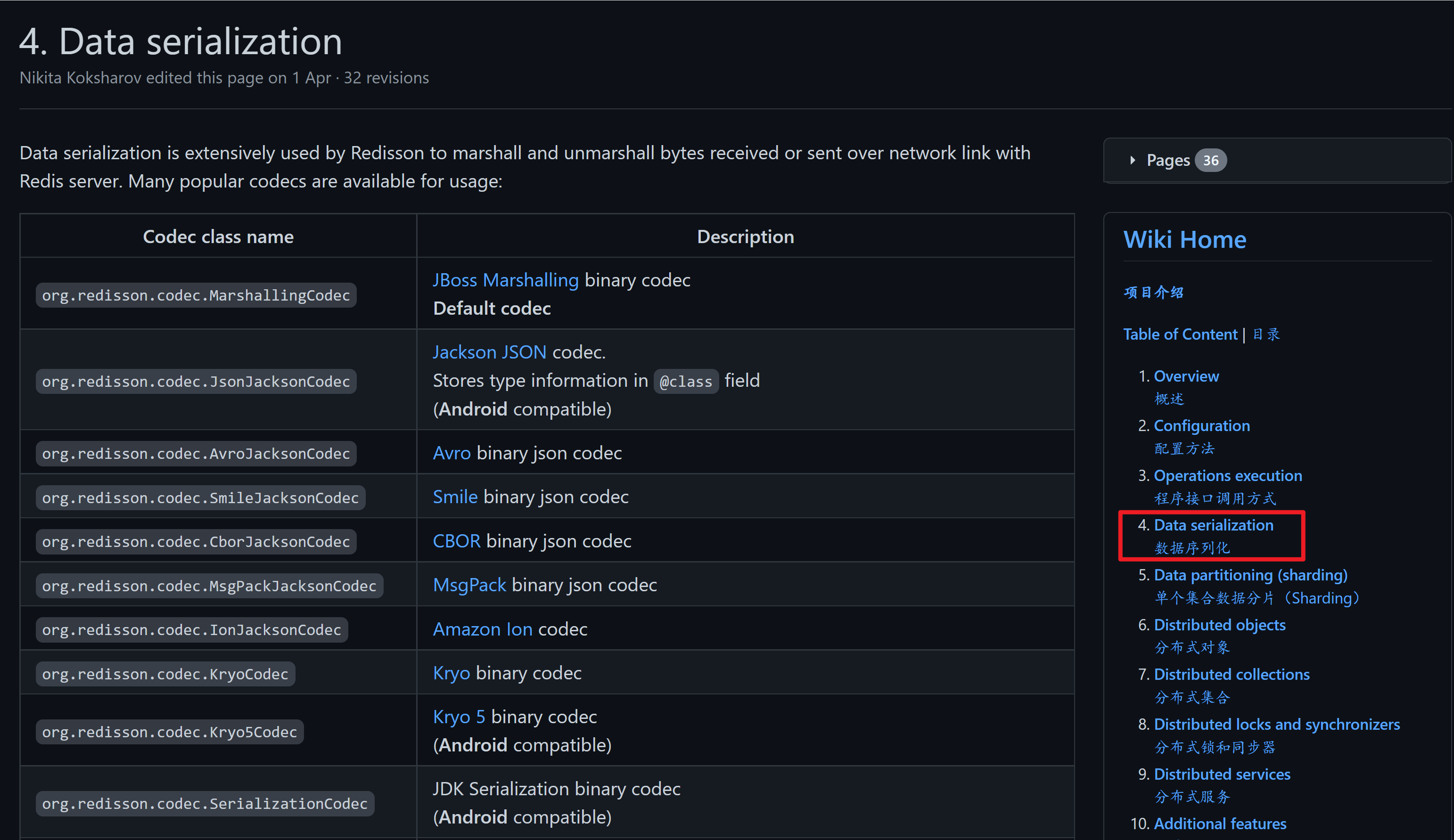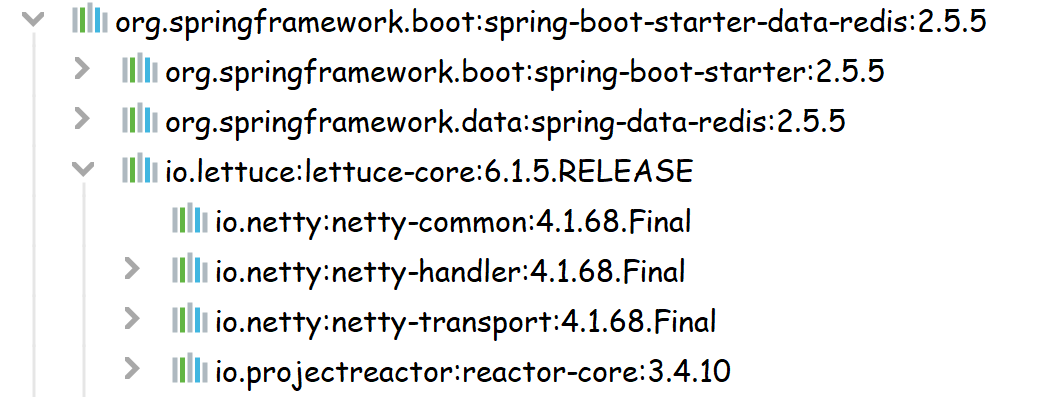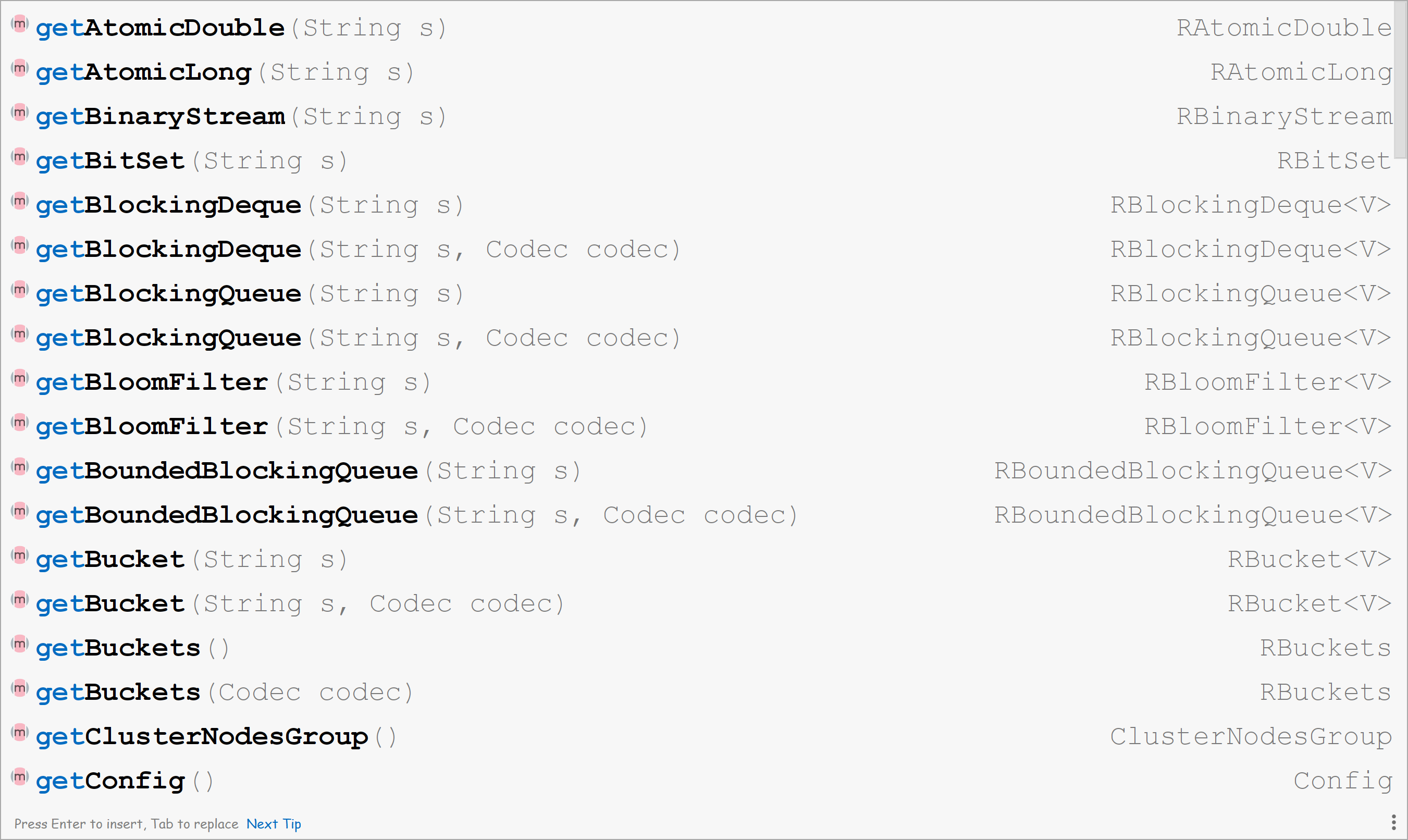一、Jedis,Redisson,Lettuce 三者的区别
共同点:都提供了基于 Redis 操作的 Java API,只是封装程度,具体实现稍有不同。
不同点:
- 1.1、Jedis
是 Redis 的 Java 实现的客户端。支持基本的数据类型如:String、Hash、List、Set、Sorted Set。
特点:使用阻塞的 I/O,方法调用同步,程序流需要等到 socket 处理完 I/O 才能执行,不支持异步操作。Jedis 客户端实例不是线程安全的,需要通过连接池来使用 Jedis。
- 1.1、Redisson
优点点:分布式锁,分布式集合,可通过 Redis 支持延迟队列。
- 1.3、 Lettuce
用于线程安全同步,异步和响应使用,支持集群,Sentinel,管道和编码器。
基于 Netty 框架的事件驱动的通信层,其方法调用是异步的。Lettuce 的 API 是线程安全的,所以可以操作单个 Lettuce 连接来完成各种操作。
二、Jedis
三、RedisTemplate
3.1、使用配置
Maven配置引入,(要加上版本号,这里是因为 Parent 已声明)
<dependency><groupId>org.springframework.boot</groupId><artifactId>spring-boot-starter-data-redis</artifactId></dependency>
application-dev.yml
spring:redis:host: 192.168.1.140port: 6379password:database: 15 # 指定redis的分库(共16个0到15)
3.2、使用示例
@Overridepublic CustomersEntity findById(Integer id) {// 需要缓存// 所有涉及的缓存都需要删除,或者更新try {String toString = stringRedisTemplate.opsForHash().get(REDIS_CUSTOMERS_ONE, id + "").toString();if (toString != null) {return JSONUtil.toBean(toString, CustomersEntity.class);}} catch (Exception e) {e.printStackTrace();}// 缓存为空的时候,先查,然后缓存redisOptional<CustomersEntity> byId = customerRepo.findById(id);if (byId.isPresent()) {CustomersEntity customersEntity = byId.get();try {stringRedisTemplate.opsForHash().put(REDIS_CUSTOMERS_ONE, id + "", JSONUtil.toJsonStr(customersEntity));} catch (Exception e) {e.printStackTrace();}return customersEntity;}return null;}
3.3、扩展
3.3.1、spring-boot-starter-data-redis 的依赖包
3.3.2、stringRedisTemplate API(部分展示)
opsForHash —> hash 操作
opsForList —> list 操作
opsForSet —> set 操作
opsForValue —> string 操作
opsForZSet —> Zset 操作
3.3.3、StringRedisTemplate 默认序列化机制
public class StringRedisTemplate extends RedisTemplate<String, String> {/*** Constructs a new <code>StringRedisTemplate</code> instance. {@link #setConnectionFactory(RedisConnectionFactory)}* and {@link #afterPropertiesSet()} still need to be called.*/public StringRedisTemplate() {RedisSerializer<String> stringSerializer = new StringRedisSerializer();setKeySerializer(stringSerializer);setValueSerializer(stringSerializer);setHashKeySerializer(stringSerializer);setHashValueSerializer(stringSerializer);}}
四、RedissonClient 操作示例
4.1 基本配置
4.1.1、Maven pom 引入
<dependency><groupId>org.springframework.boot</groupId><artifactId>spring-boot-starter-data-redis</artifactId></dependency><dependency><groupId>org.redisson</groupId><artifactId>redisson</artifactId><version>3.8.2</version><optional>true</optional></dependency><dependency><groupId>org.redisson</groupId><artifactId>redisson-spring-boot-starter</artifactId><version>LATEST</version></dependency>
4.1.2、添加配置文件 Yaml 或者 json 格式
redisson-config.yml
# Redisson 配置singleServerConfig:address: "redis://192.168.1.140:6379"password: nullclientName: nulldatabase: 15 #选择使用哪个数据库0~15idleConnectionTimeout: 10000pingTimeout: 1000connectTimeout: 10000timeout: 3000retryAttempts: 3retryInterval: 1500reconnectionTimeout: 3000failedAttempts: 3subscriptionsPerConnection: 5subscriptionConnectionMinimumIdleSize: 1subscriptionConnectionPoolSize: 50connectionMinimumIdleSize: 32connectionPoolSize: 64dnsMonitoringInterval: 5000#dnsMonitoring: falsethreads: 0nettyThreads: 0codec:class: "org.redisson.codec.JsonJacksonCodec"transportMode: "NIO"
或者,配置 redisson-config.json
{"singleServerConfig": {"idleConnectionTimeout": 10000,"pingTimeout": 1000,"connectTimeout": 10000,"timeout": 3000,"retryAttempts": 3,"retryInterval": 1500,"reconnectionTimeout": 3000,"failedAttempts": 3,"password": null,"subscriptionsPerConnection": 5,"clientName": null,"address": "redis://192.168.1.140:6379","subscriptionConnectionMinimumIdleSize": 1,"subscriptionConnectionPoolSize": 50,"connectionMinimumIdleSize": 10,"connectionPoolSize": 64,"database": 0,"dnsMonitoring": false,"dnsMonitoringInterval": 5000},"threads": 0,"nettyThreads": 0,"codec": null,"useLinuxNativeEpoll": false}
4.1.3、读取配置
新建读取配置类
@Configurationpublic class RedissonConfig {@Beanpublic RedissonClient redisson() throws IOException {// 两种读取方式,Config.fromYAML 和 Config.fromJSON// Config config = Config.fromJSON(RedissonConfig.class.getClassLoader().getResource("redisson-config.json"));Config config = Config.fromYAML(RedissonConfig.class.getClassLoader().getResource("redisson-config.yml"));return Redisson.create(config);}}
或者,在 application.yml 中配置如下
spring:redis:redisson:config: classpath:redisson-config.yaml
4.2 使用示例
@RestController@RequestMapping("/")public class TeController {@Autowiredprivate RedissonClient redissonClient;static long i = 20;static long sum = 300;// ========================== String =======================@GetMapping("/set/{key}")public String s1(@PathVariable String key) {// 设置字符串RBucket<String> keyObj = redissonClient.getBucket(key);keyObj.set(key + "1-v1");return key;}@GetMapping("/get/{key}")public String g1(@PathVariable String key) {// 设置字符串RBucket<String> keyObj = redissonClient.getBucket(key);String s = keyObj.get();return s;}// ========================== hash =======================-=@GetMapping("/hset/{key}")public String h1(@PathVariable String key) {Ur ur = new Ur();ur.setId(MathUtil.randomLong(1,20));ur.setName(key);// 存放 HashRMap<String, Ur> ss = redissonClient.getMap("UR");ss.put(ur.getId().toString(), ur);return ur.toString();}@GetMapping("/hget/{id}")public String h2(@PathVariable String id) {// hash 查询RMap<String, Ur> ss = redissonClient.getMap("UR");Ur ur = ss.get(id);return ur.toString();}// 查询所有的 keys@GetMapping("/all")public String all(){RKeys keys = redissonClient.getKeys();Iterable<String> keys1 = keys.getKeys();keys1.forEach(System.out::println);return keys.toString();}// ================== ==============读写锁测试 =============================@GetMapping("/rw/set/{key}")public void rw_set(){// RedissonLock.RBucket<String> ls_count = redissonClient.getBucket("LS_COUNT");ls_count.set("300",360000000l, TimeUnit.SECONDS);}// 减法运算@GetMapping("/jf")public void jf(){String key = "S_COUNT";// RAtomicLong atomicLong = redissonClient.getAtomicLong(key);// atomicLong.set(sum);// long l = atomicLong.decrementAndGet();// System.out.println(l);RAtomicLong atomicLong = redissonClient.getAtomicLong(key);if (!atomicLong.isExists()) {atomicLong.set(300l);}while (i == 0) {if (atomicLong.get() > 0) {long l = atomicLong.getAndDecrement();try {Thread.sleep(1000l);} catch (InterruptedException e) {e.printStackTrace();}i --;System.out.println(Thread.currentThread().getName() + "->" + i + "->" + l);}}}@GetMapping("/rw/get")public String rw_get(){String key = "S_COUNT";Runnable r = new Runnable() {@Overridepublic void run() {RAtomicLong atomicLong = redissonClient.getAtomicLong(key);if (!atomicLong.isExists()) {atomicLong.set(300l);}if (atomicLong.get() > 0) {long l = atomicLong.getAndDecrement();i --;System.out.println(Thread.currentThread().getName() + "->" + i + "->" + l);}}};while (i != 0) {new Thread(r).start();// new Thread(r).run();// new Thread(r).run();// new Thread(r).run();// new Thread(r).run();}RBucket<String> bucket = redissonClient.getBucket(key);String s = bucket.get();System.out.println("================线程已结束================================" + s);return s;}}
4.3 扩展
4.3.1 丰富的 jar 支持,尤其是对 Netty NIO 框架
4.3.2 丰富的配置机制选择,这里是详细的配置说明
关于序列化机制中,就有很多

更多序列化机制详见:https://github.com/redisson/redisson/wiki/4.-data-serialization
4.3.3 API 支持(部分展示),具体的 Redis —> RedissonClient
4.3.4 轻便的丰富的锁机制的实现
4.3.4.1 Lock
4.3.4.2 Fair Lock
4.3.4.3 MultiLock
4.3.4.4 RedLock
4.3.4.5 ReadWriteLock
4.3.4.6 Semaphore
4.3.4.7 PermitExpirableSemaphore
4.3.4.8 CountDownLatch
五、基于注解实现的 Redis 缓存
5.1 Maven 和 YML 配置
参考 RedisTemplate 配置
另外,还需要额外的配置类
// todo 定义序列化,解决乱码问题@EnableCaching@Configuration@ConfigurationProperties(prefix = "spring.cache.redis")public class RedisCacheConfig {private Duration timeToLive = Duration.ZERO;public void setTimeToLive(Duration timeToLive) {this.timeToLive = timeToLive;}@Beanpublic CacheManager cacheManager(RedisConnectionFactory factory) {RedisSerializer<String> redisSerializer = new StringRedisSerializer();Jackson2JsonRedisSerializer jackson2JsonRedisSerializer = new Jackson2JsonRedisSerializer(Object.class);// 解决查询缓存转换异常的问题ObjectMapper om = new ObjectMapper();om.setVisibility(PropertyAccessor.ALL, JsonAutoDetect.Visibility.ANY);om.enableDefaultTyping(ObjectMapper.DefaultTyping.NON_FINAL);jackson2JsonRedisSerializer.setObjectMapper(om);// 配置序列化(解决乱码的问题)RedisCacheConfiguration config = RedisCacheConfiguration.defaultCacheConfig().entryTtl(timeToLive).serializeKeysWith(RedisSerializationContext.SerializationPair.fromSerializer(redisSerializer)).serializeValuesWith(RedisSerializationContext.SerializationPair.fromSerializer(jackson2JsonRedisSerializer)).disableCachingNullValues();RedisCacheManager cacheManager = RedisCacheManager.builder(factory).cacheDefaults(config).build();return cacheManager;}}
5.2 使用示例
@Transactional@Servicepublic class ReImpl implements RedisService {@Resourceprivate CustomerRepo customerRepo;@Resourceprivate StringRedisTemplate stringRedisTemplate;public static final String REDIS_CUSTOMERS_ONE = "Customers";public static final String REDIS_CUSTOMERS_ALL = "allList";// =====================================================================使用Spring cahce 注解方式实现缓存// ==================================单个操作@Override@Cacheable(value = "cache:customer", unless = "null == #result",key = "#id")public CustomersEntity cacheOne(Integer id) {final Optional<CustomersEntity> byId = customerRepo.findById(id);return byId.isPresent() ? byId.get() : null;}@Override@Cacheable(value = "cache:customer", unless = "null == #result", key = "#id")public CustomersEntity cacheOne2(Integer id) {final Optional<CustomersEntity> byId = customerRepo.findById(id);return byId.isPresent() ? byId.get() : null;}// todo 自定义redis缓存的key,@Override@Cacheable(value = "cache:customer", unless = "null == #result", key = "#root.methodName + '.' + #id")public CustomersEntity cacheOne3(Integer id) {final Optional<CustomersEntity> byId = customerRepo.findById(id);return byId.isPresent() ? byId.get() : null;}// todo 这里缓存到redis,还有响应页面是String(加了很多转义符\,),不是Json格式@Override@Cacheable(value = "cache:customer", unless = "null == #result", key = "#root.methodName + '.' + #id")public String cacheOne4(Integer id) {final Optional<CustomersEntity> byId = customerRepo.findById(id);return byId.map(JSONUtil::toJsonStr).orElse(null);}// todo 缓存json,不乱码已处理好,调整序列化和反序列化@Override@Cacheable(value = "cache:customer", unless = "null == #result", key = "#root.methodName + '.' + #id")public CustomersEntity cacheOne5(Integer id) {Optional<CustomersEntity> byId = customerRepo.findById(id);return byId.filter(obj -> !StrUtil.isBlankIfStr(obj)).orElse(null);}// ==================================删除缓存@Override@CacheEvict(value = "cache:customer", key = "'cacheOne5' + '.' + #id")public Object del(Integer id) {// 删除缓存后的逻辑return null;}@Override@CacheEvict(value = "cache:customer",allEntries = true)public void del() {}@CacheEvict(value = "cache:all",allEntries = true)public void delall() {}// ==================List操作@Override@Cacheable(value = "cache:all")public List<CustomersEntity> cacheList() {List<CustomersEntity> all = customerRepo.findAll();return all;}// todo 先查询缓存,再校验是否一致,然后更新操作,比较实用,要清楚缓存的数据格式(明确业务和缓存模型数据)@Override@CachePut(value = "cache:all",unless = "null == #result",key = "#root.methodName")public List<CustomersEntity> cacheList2() {List<CustomersEntity> all = customerRepo.findAll();return all;}}
5.3 扩展
基于 spring 缓存实现



